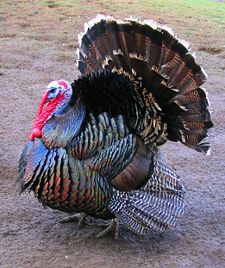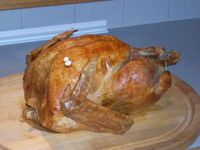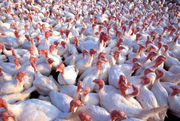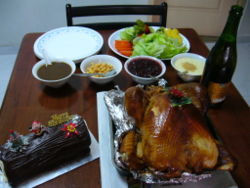Domestic turkey
2008/9 Schools Wikipedia Selection. Related subjects: Birds
| Domesticated turkey | ||||||||||||
|---|---|---|---|---|---|---|---|---|---|---|---|---|
 A domestic male North American turkey M. gallopavo
|
||||||||||||
| Conservation status | ||||||||||||
|
Template:StatusDomesticated
|
||||||||||||
| Scientific classification | ||||||||||||
|
||||||||||||
| Species | ||||||||||||
|
Meleagris gallopavo (modern) |
The domesticated turkey is a large poultry bird raised for food. The modern domesticated turkey descends from the wild turkey (Meleagris gallopavo), one of the two species of turkey (genus Meleagris); however, in the past the ocellated turkey (Meleagris ocellata) was also domesticated. Despite the name, turkeys have no relation to the country of Turkey and are native to North America.
The turkey is reared throughout temperate parts of the world, and is a popular form of poultry, partially because industrialised farming has made it very cheap for the amount of meat it produces. The female domesticated turkey is referred to as a hen and the chick as a poult. In the United States, the male is referred to as a tom, whilst in Europe, the male is a stag.
The great majority of domesticated turkeys have white feathers, although brown or bronze-feathered varieties are also raised. The fleshy protuberance attached to the underside of the beak is known as a "wattle".
History
Since the modern domesticated turkey is a descendant of the Wild Turkey, it is surmised that ancient Mesoamericans had chosen to domesticate this species rather than the Ocellated Turkey which is found in far southern Mexico. The Aztecs relied on the turkey ( Mexican Spanish guajolote, from Nahuatl huexolotl) as a major source of protein (meat and eggs), and also utilized its feathers extensively for decorative purposes, as did many other Mesoamerican cultures. The turkey was associated with their trickster god Tezcatlipoca, perhaps because of its humorous behaviour, an aspect which it has retained up to the present. In Mexico today, turkey meat with mole sauce (mole de guajolote) is widely regarded as the unofficial national dish.
Turkeys were taken to Europe by the Spanish who had found them as a favorite domesticated animal among the Aztecs and other Mesoamerican peoples. After being introduced to Europe many distinct turkey breeds were developed due to cross breeding (e.g. Spanish Black, Royal Palm). Turkey was one of the many game species hunted by early American colonists and is thought to have been served at the first Thanksgiving, although there is little evidence to support this claim. Most likely, venison and/or duck was served at the first thanksgiving. In the midwestern United States in the mid to late 1800s, domestic turkeys were actually herded across the range in a manner similar to herding cattle. In the early 20th century, many advances were made in the breeding of turkeys resulting in varieties such as the Beltsville Small White.
Suggestions have been made that the Mexican Ocellated Turkey (Meleagris ocellata) might also be involved, but the plumage as well as DNA analysis of domestic turkeys does not support this theory; in particular, the chest tuft of domestic turkeys is a clear indicator of descent from the Wild Turkey (the Ocellated Turkey does not have this tuft).
Availability and commercial production
Prior to World War II, turkey was something of a luxury in Britain, with goose or beef a more common Christmas dinner (In Charles Dickens' A Christmas Carol, Bob Cratchit had a goose before Scrooge bought him a turkey).
Turkey production in Britain was centred on East Anglia with two breeds, the Norfolk Black and the Norfolk Bronze (also known as Cambridge Bronze). These would be driven as flocks, after shoeing, down to markets in London from the 17th century onwards - the breeds arriving in the early 16th century via Spain (1500).
Intensive farming of turkeys from the late 1940s, however, dramatically cut the price and it became far and away the most common Christmas dinner meat. With the availability of refrigeration, whole turkeys could be shipped frozen to distant markets. Later advances in control of disease increased production even more. Advances in shipping, changing consumer preferences and the proliferation of commercial poultry plants for butchering animals has made fresh turkey available to the consumer.
In the UK Bernard Matthews is a name synonymous with turkey production and the largest single producer in the world. The dominant commercial breed is the White (also known as "White Holland") which are large birds with lots of meat but too large to achieve natural fertilization.
Waste products
Approximately two to four billion pounds of poultry feathers are produced every year by the poultry producing industry. Most of the feathers are usually ground up and used as filler for animal feed. Researchers at the United States Department of Agriculture (USDA) have patented a method of removing the stiff quill from the fibers which make up the feather. As this is a potential untapped supply of natural fibers, research has been conducted at Philadelphia University to determine textile applications for feather fibers. To date, turkey feather fibers have been blended with nylon and spun into yarn which was then used for knitting. The yarns were tested for strength while the fabrics were evaluated as potential insulation materials. In the case of the yarns, as the percentage of turkey feather fibers increased the strength decreased. In fabric form, as the percentage of turkey feather fibers increased the heat retention capability of the fabric increased.
Intelligence
Turkeys are popularly believed to be unintelligent birds with claims made that during a rain storm a turkey will look up into the sky until they drown. Despite this image, the turkey is no more or less intelligent than a comparable animal, and while the birds will look at the sky for up to a minute during a rain storm, this is due to a genetic nervous disorder known as tetanic torticollar spasms. Other criticisms include the bird being 'too dumb' to realize it can't fly, and perceptions about the bird being awkward, both traits being due to the breeding of modern turkeys to be much heavier than their wild relatives to provide more meat for human meals. Benjamin Franklin regarded the turkey as a noble bird and preferred it to the eagle as the proposed symbol for the new United States, describing it as a "Bird of Courage."
Turkey breeds
- The Broad-breasted White is the commercial turkey of choice for large scale industrial turkey farms, and consequently is the most consumed variety of the bird. Usually the turkey to receive a "presidential pardon", a US custom, is a Broad breasted White.
- The Broad-breasted Bronze is another commercially developed strain of table bird.
- The Standard Bronze looks much like the broad-breasted, except that it is single breasted, and can naturally breed.
- The Bourbon Red turkey is a smaller non-commercial breed with dark reddish feathers with white markings.
- Blue slate turkeys are a very rare breed with beautiful gray-blue feathers.
- The Black turkey ("Spanish Black", "Norfolk Black") has very dark plumage with a green sheen.
- The Narraganset is a popular heritage breed named after Narraganset Bay in New England.
- The Chocolate Turkey is a rarer heritage breed with markings similar to a Black Spanish, but light brown instead of black in colour. Common in the Southern U.S. and France before the Civil War.
- The Beltsville Small White is a small heritage breed, which development started in 1934. She was introduced in 1941 and was admitted to the APA Standard in 1951. She is slightly bigger and broader than the Midget White but both are often mislabel.
- The Midget White Turkey is a smaller heritage breed, developed in Massachusetts in the 1950's, sometimes called Beltsville Whites.
- The striking Royal Palm turkey has been developed not as a commercial strain but for more ornamental purposes, though it is also bred by those interested in preserving heritage breeds.
The average lifespan of a breeding tom is 64 weeks. Between the hen and the tom, the tom is the only one that "gobbles".
Turkeys as food
Turkeys are traditionally eaten as the main course of large feasts at Christmas in much of the world, as well as Thanksgiving in the United States and Canada, though this tradition has its origins in modern times, rather than colonial as is often supposed. In fact, before the 20th century, pork ribs were the most commonly consumed food on the holiday, as the animals were usually slaughtered in November. Turkeys were once so abundant in the wild that they were eaten throughout the year, the food considered commonplace, whereas pork ribs were rarely available outside of the Thanksgiving-New Year holiday season. It has also displaced, to a certain extent, the traditional Christmas roast goose or beef of Britain and Europe. While eating turkey was once mainly restricted to special occasions such as these, turkey is now eaten year-round and forms a regular part of many diets.
In countries where turkey is popular, it is available commonly in supermarkets. Turkeys are sold sliced and ground, as well as "whole" in a manner similar to chicken with the head, feet, and feathers removed. Frozen whole turkeys remain popular. Sliced turkey is frequently used as a sandwich meat or served as cold cuts. Ground turkey is sold just as ground beef, and is frequently marketed as a healthy beef substitute. Without proper preparation, turkey is usually considered to end up less moist than, for example, chicken or duck. Leftovers from roast turkey are generally served as cold cuts on Boxing Day. In Israel, turkey, rather than lamb is usually the choice meat used to make shawarma.

Wild turkeys, while technically the same species as domesticated turkeys, have a very different taste from farm-raised turkeys. Almost all of the meat is "dark" (even the breasts) with a more intense turkey flavor. The flavour can also vary seasonally with changes in available forage, often leaving wild turkey meat with a more significant game flavour in late summer due to the greater number of insects in the diet over the preceding months. Wild turkey that has fed predominantly on grass and grain has a far milder flavour. Older heritage breeds also differ in flavor.
Turkey is often found as a processed meat. It can be smoked and as such is sometimes sold as turkey ham. Twisted helices of deep fried turkey meat sold as turkey twizzlers came to prominence in the UK in 2004 when chef Jamie Oliver campaigned to have them and similar foods removed from school dinners.
Cooking
Both fresh and frozen turkeys are used for cooking; as with most foods, fresh turkeys are generally preferred, although they cost more. Around holiday seasons, high demand for fresh turkeys often makes them difficult to purchase without ordering in advance. For the frozen variety, the large size of the turkeys typically used for consumption makes defrosting them a major endeavour: a typically-sized turkey will take several days to properly defrost.
Turkeys are usually baked or roasted in an oven for several hours, often while the cook prepares the rest of the meal. Sometimes, a turkey is brined before roasting to enhance flavor and moisture content. This is necessary because the dark meat cooks more slowly than the white meat, so that fully cooking the dark meat tends to dry out the breast. Brining makes it possible to fully cook the dark meat without drying the breast meat. Turkeys are sometime decorated with turkey frills prior to serving.
In some areas, particularly the American South, they may also be deep fried in hot oil (often peanut oil) for 30 to 45 minutes by using a turkey fryer. Deep frying turkey has become something of a fad, with hazardous consequences for those unprepared to safely handle the large quantities of hot oil required.
Nutritional value
| Turkey breast meat Nutritional value per 100 g (3.5 oz) |
||||||||||||||||||||||||||||||||||
|---|---|---|---|---|---|---|---|---|---|---|---|---|---|---|---|---|---|---|---|---|---|---|---|---|---|---|---|---|---|---|---|---|---|---|
| Energy 100 kcal 440 kJ | ||||||||||||||||||||||||||||||||||
|
||||||||||||||||||||||||||||||||||
| Percentages are relative to US recommendations for adults. Source: USDA Nutrient database |
||||||||||||||||||||||||||||||||||
Turkey is generally considered healthier and less fattening than red meat. Turkey is high in tryptophan, and is commonly credited with causing sleepiness after a meal; however, this is largely a misconception. Turkey dinners are commonly large meals served with carbohydrates, fats, and alcohol in a relaxed atmosphere, all of which are bigger contributors to post-meal sleepiness than the tryptophan in turkey.
Accompaniments
When eaten at Christmas in Britain, turkey is traditionally served with winter vegetables including roast potatoes, Brussels sprouts, and parsnips. Cranberry sauce is the traditional condiment in the northern rural areas of Britain where wild cranberries grow. In the south and in urban areas, where cranberries until recently were difficult to obtain, bread sauce was used in its place, but the availability of commercial cranberry sauce has seen a rise in its popularity in these areas too. Sometimes sausagemeat, cocktail sausages or liver wrapped in bacon is also served (known as bacon rolls or " pigs in blankets").
Especially during holiday seasons, stuffing is traditionally served with turkey. There are many varieties: oatmeal, chestnut, sage and onion (flavoured bread), and sausage (possibly with mashed potato) are the most traditional. Stuffing may either be used to stuff the turkey (as the name implies), or may be cooked separately and served as a side dish.
For Thanksgiving in the United States and Canada, turkey is traditionally served with cranberry sauce and gravy. Other items vary, but common complementary dishes include mashed potatoes, dinner rolls, various vegetables (such as corn, green beans, squash, and sweet potatoes), and various types of pie for dessert (such as pumpkin, apple and pecan). One humorous decades-old Thanksgiving tradition in the United States is the annual Presidential "pardon" of a selected turkey, which meets the President and then is taken to a petting zoo instead of a slaughterhouse.

